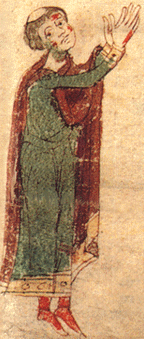...Best of Sicily presents... Best of Sicily Magazine. ... Dedicated to Sicilian art, culture, history, people, places and all things Sicilian. |
by Daniela Paglia | ||
Magazine Index Best of Sicily Arts & Culture Fashion Food & Wine History & Society About Us Travel Faqs Contact Map of Sicily |
Peter was born at Eboli, south of Naples in the foothills of the mountains leading toward Potenza, some time after 1150. He seems to have been of a noble family, possibly Norman, but this is not known for certain. By the late 1190s, Peter was a court poet of Henry VI, King of Sicily and Holy Roman Emperor (perhaps best known in Sicilian history as the father of Frederick II). It appears that he was also a physician, and lived for a time at Palermo, where in 1196 he composed a volume of verse (Liber ad Honorem Augusti, sive de rebus Siculis) to honour the emperor. Peter of Eboli, who had previously resided at Montecassino, the premier Benedictine monastery, was something of a sycophant, as least so far as the Swabians were concerned. His perspective is sometimes unnecessarily critical of the latter norman kings, namely Willian I, Willian II and particularly the claimant Tancred. Nevertheless, his illuminated manuscript is a precious reference, and reasonably accurate regarding events closer to 1200, as well as court life of the period. Peter of Eboli died around 1221. Peter's Gesta Federici (Deeds of Frederick) has been lost to time. It surely would have increased our knowledge of Frederick Barbarossa. (Contrary to popular belief, it was not written about Frederick II.) He also authored a book about the thermal baths of Pozzuoli, near Naples. This was a kind of tourists' guide to a natural resource considered curative. Nowadays it is all too easy to be cynical about Peter's biased points of view. The historian John Julius Norwich, in particular, sought to consider the monk's observations critically but with a balanced eye. In an age before printing, manuscripts such as Brother Peter's serve to provide us with information on events beyond mere legal and bureaucratic records, complemented by works such as those of the court geographer Abdulla al Idrisi. Perhaps we should also remember that even today's sophisticated news organisations are sometimes accused of political, nationalistic or self-interested bias. For his time, Peter of Eboli was as accurate as one could expect. About the Author: Freelance journalist Daniela Paglia formerly taught history and Italian studies in a high school in Catania. | |
Top of Page |
 Cynical, biased, eccentric, perhaps a touch nasty, Peter of Eboli is one of the principal chroniclers of the
Cynical, biased, eccentric, perhaps a touch nasty, Peter of Eboli is one of the principal chroniclers of the